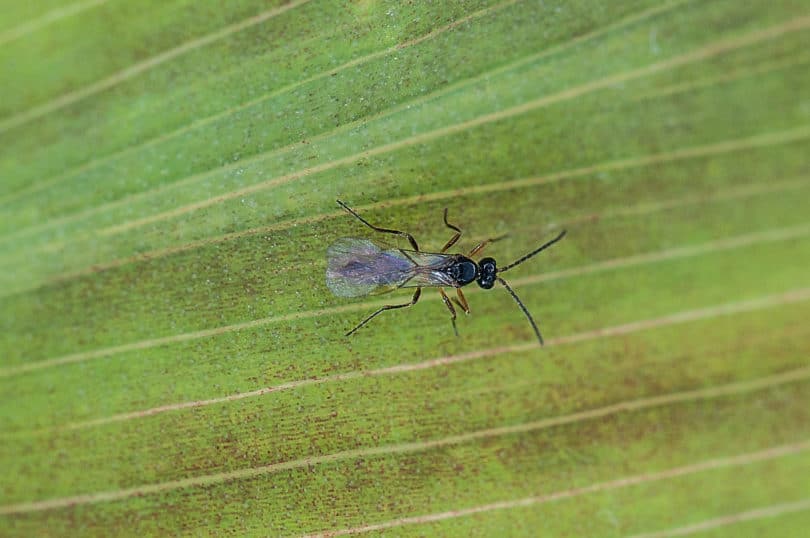2012 Benelli, G.; Raspi, A.; Canale, A. (2012): Behavioural responses of the fruit fly parasitoid Psyttalia concolor (Szepligeti) (Hymenoptera: Braconidae) to fruits infested by Ceratitis capitata (Wiedemann) (Diptera: Tephritidae). IOBC/WPRS Bulletin 74 141-146. Ovruski, S.; Van Nieuwenhove, G.; Bezdjian, L.; Albornoz-Medina, P.; Schliserman, P. (2012): Evaluation of Diachasmimorpha longicaudata (Hymenoptera: Braconidae) as a mortality factor […]
Hymenoptera
Aphidius colemani – Schlupfwespe
Wissenschaftlicher Name: Aphidius colemani VIERECK Volksnamen: Schlupfwespe Synonyme: Aphidius aphidiphilus Benoit Aphidius huebrichi Brèthes Aphidius leroyi Benoit Aphidius platensis Brèthes Aphidius porteri Brèthes Aphidius transcaspicus Telenga Familie: Hautflügler (Hymenoptera) Schädlinge gegen die Aphidius colemani angewendet wird: verschiedene Blattlausarten, Schwarze Wickenlaus (Aphis craccivora), Efeublattlaus (Aphis hederae), Grüne Gurkenblattlaus (Aphis gossypii), Oleanderlaus (Aphis nerii), gefleckte Gewächshausblattlaus (Aulacorthum circumflexum), Grosse Zwetschgenblattlaus (Brachycaudus cardui), Grüne […]
Venturia canescens
2013 Foray, V.; Henri, H.; Martinez, S.; Gibert, P.; Desouhant, E. (2013): Occurrence of arrhenotoky and thelytoky in a parasitic wasp Venturia canescens (Hymenoptera: Ichneumonidae): Effect of endosymbionts or existence of two distinct reproductive modes? European Journal of Entomology 110 (1): 103-107. [ad name=“A“] 2012 Belda, C.; Riudavets, J. (2012): The influence of the rearing […]
Trichogramma evanescens
2013 Watanabe, M.; Kageyama, D.; Miura, K. (2013): Transfer of a parthenogenesis-inducing Wolbachia endosymbiont derived from Trichogramma dendrolimi into Trichogramma evanescens. Journal of Invertebrate Pathology 112 (1): 83-87. [ad name=“A“] 2012 Mandour, N. S.; Sarhan, A. A.; Atwa, D. H. (2012): The integration between Trichogramma evanescens West. (Hymenoptera: Trichogrammatidae) and selected bioinsecticides for controlling the […]
Coccophagus scutellaris
2011 Abd-Rabou, S. (2011): Field efficacy of parasitoid, Coccophagus scutellaris (Hymenoptera: Aphelinidae) and the predator, Exochomus flavipes (Coleoptera: Coccinellidae) against Pulvinaria psidii (Hemiptera: Coccidae) in Egypt. Journal of Biological Control 25 (2): 85-91. [ad name=“A“] 2008 Abd-Rabou, S. (2008): The effect of augmentative releases of indigenous parasitoid, Coccophagus scutellaris (Hymenoptera: Aphelinidae) on populations of Pulvinaria […]
Coccophagus lycimnia
1989 Muegge, M. A.; Lambdin, P. L. (1989): longevity and fecundity of Coccophagus lycimnia walker hymenoptera aphelinidae a primary parasitoid of Coccus hesperidum homoptera coccidae. Journal of Agricultural Entomology 6 (3): 169-174. Muegge, M. A.; Lambdin, P. L. (1989): Optimal Length of Coccus hesperidum L (Homoptera, Coccidae) For Parasitism By Coccophagus lycimnia (Walker) (Hymenoptera, Aphelinidae). […]
Coccidoxenoides perminutus
2010 Ceballo, F. A.; Walter, G. H.; Rochester, W. (2010): The Impact of Climate on the Biological Control of Citrus Mealybug Planococcus citri (Risso) by the Parasitoid Coccidoxenoides perminutus Girault as Predicted by the Climate-Matching Program CLIMEX. Philippine Agricultural Scientist 93 (3): 317-328. [ad name=“A“] 2009 Mgocheki, N.; Addison, P. (2009): Effect of Contact Pesticides […]
Cephalonomia tarsalis
2012 Maughan, N. (2012): Cephalonomia tarsalis, a new host in urban areas. Insectes 164 21-23. 2011 Prozell, S.; Scholler, M. (2011): Biology of Cephalonomia tarsalis (Hymenoptera: Bethylidae), a video film. IOBC/WPRS Bulletin 69 162-162. 2009 Collatz, J.; Tolasch, T.; Steidle, J. L. M. (2009): Mate Finding in the Parasitic Wasp Cephalonomia tarsalis (Ashmead): More than […]
